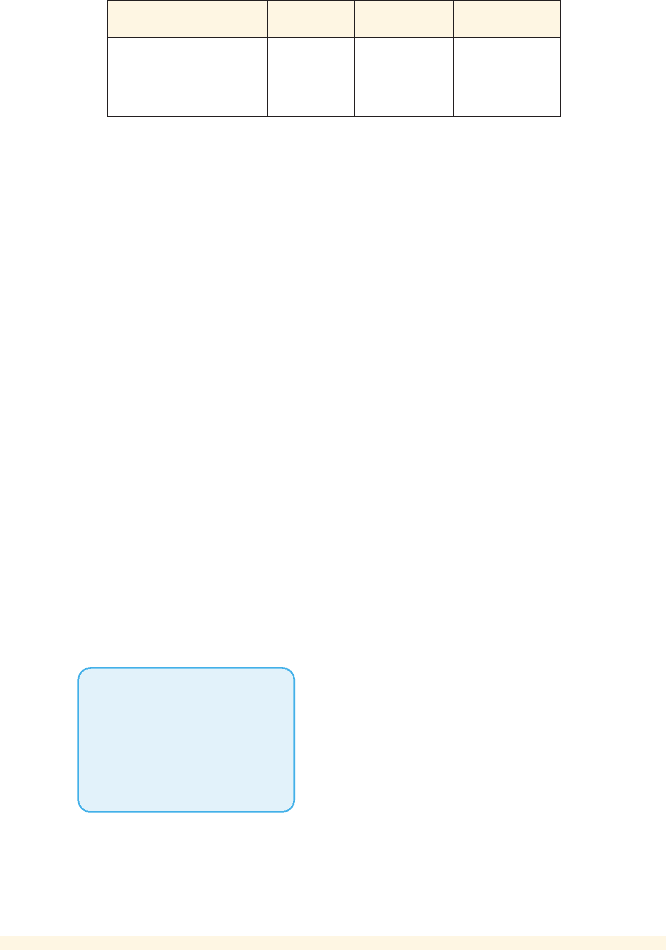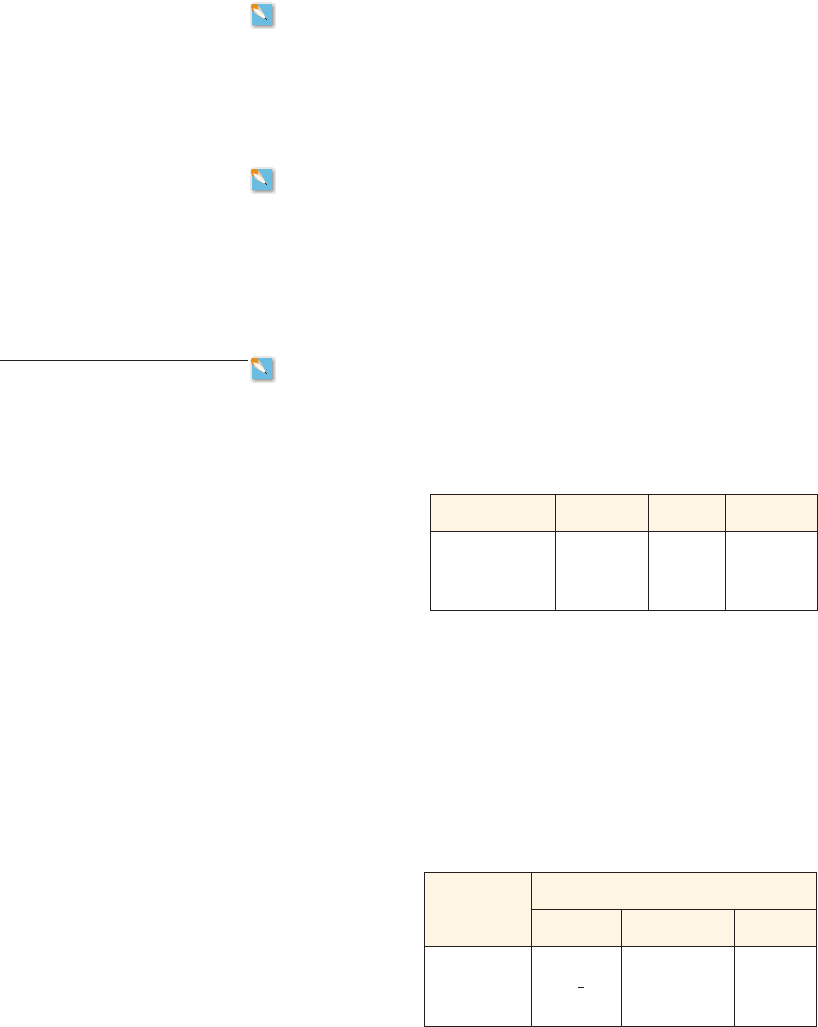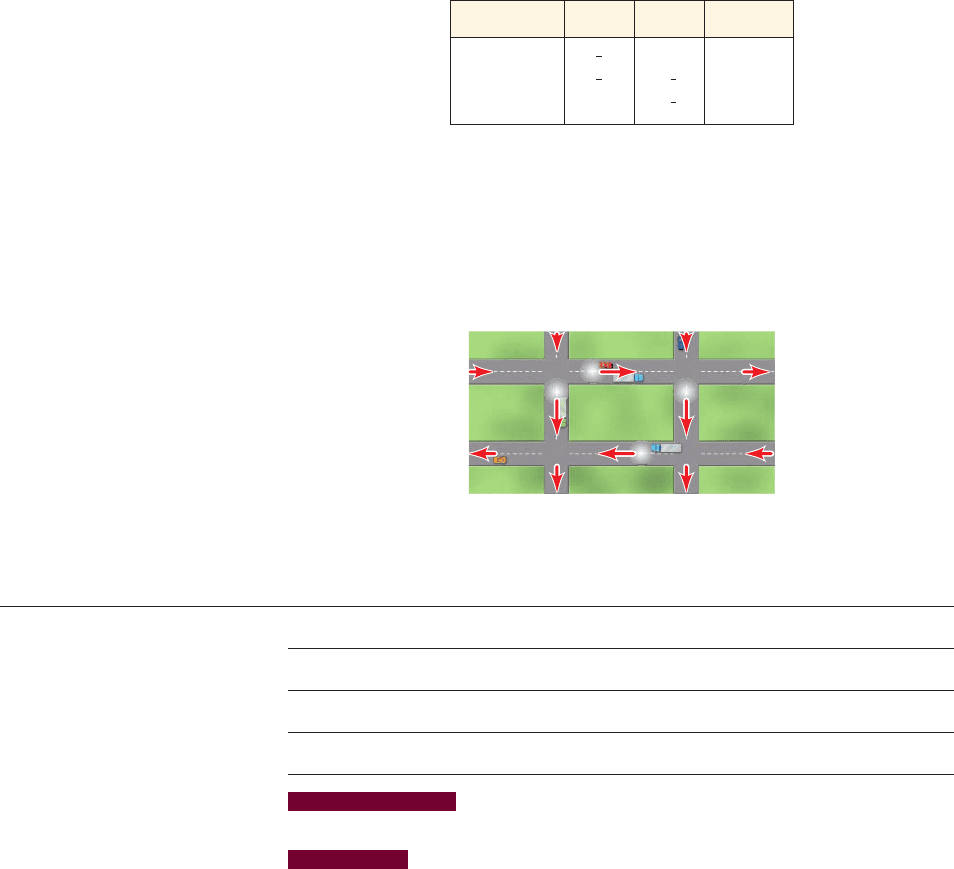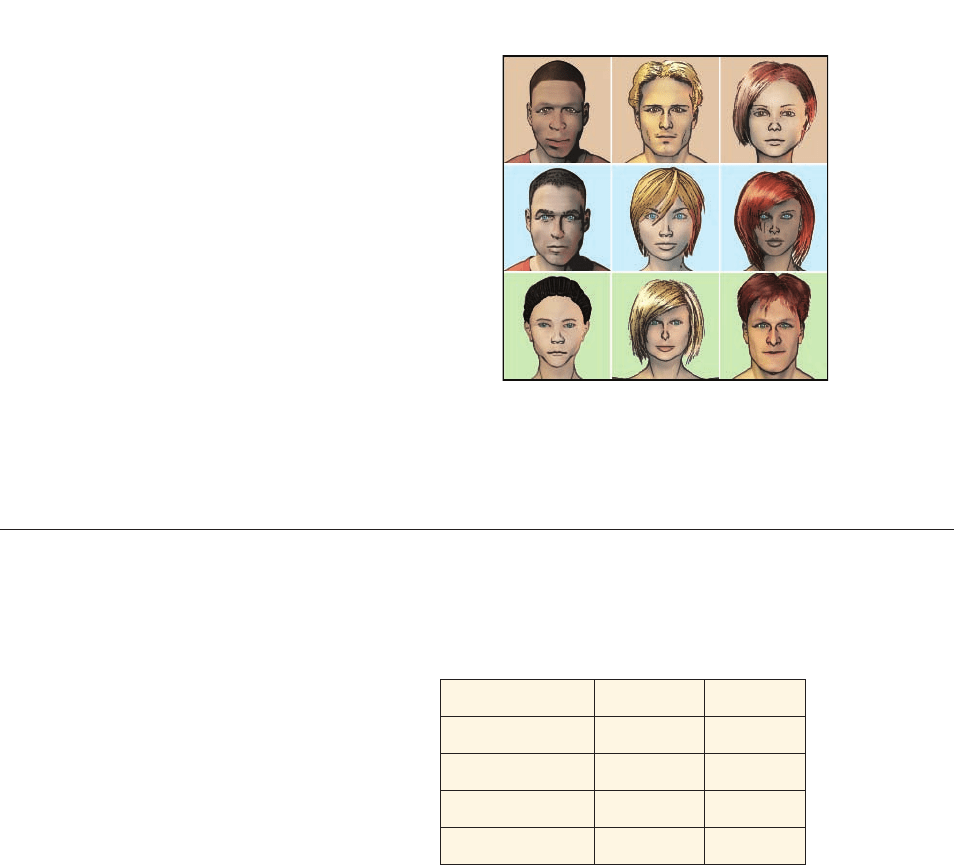Stewart J. College Algebra: Concepts and Contexts
Подождите немного. Документ загружается.


594 CHAPTER 7
■
Systems of Equations and Data in Categories
In the following matrices, the first one is in row-echelon form. The second one
is in reduced row-echelon form
£
1 00- 3
0 1 06
001 0
§£
1 6 - 25
0 1 34
00 1 8
§
2
■ Reduced Row-Echelon Form
We can use elementary row operations on the augmented matrix of a linear system
to put it into reduced row-echelon form. This form allows us to find the solutions of
the linear system without the need to use back-substitution.
Reduced Row-Echelon Form of a Matrix
A matrix is in reduced row-echelon form if it is in row-echelon form and
also satisfies the following condition:
4. Every number above and below each leading entry is a 0.
example
4
Solving a System Using Reduced Row-Echelon Form
Solve the system of linear equations using reduced row-echelon form.
Solution
This is the same system as in Example 3. We now solve this system by putting the
system into reduced row-echelon form.
Augmented matrix. The augmented matrix of this system is
£
48- 44
38 5- 11
- 21 12- 17
§
c
4x + 8y - 4z = 4
3x + 8y + 5z =-11
- 2x + y + 12z =-17
Note that the row-echelon form of a matrix is not unique. If we try to put a ma-
trix in row-echelon form, we may get different correct answers depending on which
elementary row operations we use.
Leading 1’s do not
have 0’s above
and below them.
Leading 1’s do
have 0’s above
and below them.
The reduced row-echelon form of a matrix is unique. To put an augmented matrix
into row-echelon form, we can use a graphing calculator. (On the TI-83 the com-
mand is
rref.) From the reduced row-echelon form we can just read off the solu-
tion to the system, as we show in the next example.

SECTION 7.3
■
Using Matrices to Solve Systems of Linear Equations 595
Reduced row-echelon form.
Using the rref command on a graphing calcu-
lator, we find the reduced row-echelon form of this matrix.
Calculator output Reduced row-echelon form
Solution. We now have an equivalent matrix in reduced row-echelon form, and
the corresponding system of equations is
Hence we immediately arrive at the solution .
■ NOW TRY EXERCISE 21 ■
1- 3, 1, - 22
c
x =-3
y = 1
z =-2
£
100- 3
010 1
001- 2
§
rref([A])
[[1 0 0 -3]
[0 1 0 1 ]
[0 0 1 -2]]
2
■ Inconsistent and Dependent Systems
The systems of linear equations that we considered in Examples 1 through 4 had ex-
actly one solution. But as we know from Section 7.2, a linear system may have one
solution, no solution, or infinitely many solutions. Fortunately, the reduced row-
echelon form of a system allows us to determine which of these cases applies, as de-
scribed in the following box.
First we need some terminology. A leading variable in a linear system is one
that corresponds to a leading entry in the row-echelon form of the augmented matrix
of the system.
The Solutions of a Linear System in Reduced Row-Echelon Form
Suppose the augmented matrix of a system of linear equations has been
transformed into reduced row-echelon form. Then exactly one of the
following is true.
1. No solution. If the reduced row-echelon form contains a row that repre-
sents the equation , where c is not zero, then the system has no
solution.
2. One solution. If each variable in the reduced row-echelon form is a
leading variable, then the system has exactly one solution.
3. Infinitely many solutions. If the variables in the reduced row-echelon
form are not all leading variables and if the system is not inconsistent,
then it has infinitely many solutions. We solve the system by expressing
the leading variables in terms of the nonleading variables. The
nonleading variables may take on any real numbers as their values.
0 = c

596 CHAPTER 7
■
Systems of Equations and Data in Categories
Recall that a system with no solutions is called inconsistent and a system with
infinitely many solutions is called dependent.
The matrices below, all in reduced row-echelon form, illustrate the three cases
described above.
No solution One solution Infinitely many solutions
£
12- 31
01 5- 2
00 0 0
§£
1 6 - 13
0 1 2 - 2
00 1 8
§£
1257
0134
0001
§
example
5
A System with No Solution
Solve the system.
Solution
Augmented matrix. The augmented matrix of this system is
Reduced row-echelon form. Using the rref command on a graphing calcu-
lator, we find the reduced row-echelon form of this matrix.
Calculator output Reduced row-echelon form
No solution. Now if we translate the last row back into equation form, we get
, or , which is false. No matter what values we pick for x,
y, and , the last equation will never be a true statement. This means that the
system has no solution.
■ NOW TRY EXERCISES 25 AND 33 ■
z
0 = 10x + 0y + 0z = 1
£
1050
0110
0001
§
£
1 - 3212
2 - 5514
1 - 2320
§
c
x - 3y + 2z = 12
2x - 5y + 5z = 14
x - 2y + 3z = 20
rref([A])
[[1 0 5 0]
[0 1 1 0]
[0 0 0 1]]
Last equation says
0 = 1
Each variable is a
leading variable
is not a leading
variable
z

SECTION 7.3
■
Using Matrices to Solve Systems of Linear Equations 597
example
6
A System with Infinitely Many Solutions
Find the complete solution of the system.
Solution
Augmented matrix. The augmented matrix of this system is
Row-echelon form. Using the rref command on a graphing calculator, we
find the reduced row-echelon form of this matrix.
Calculator output Reduced row-echelon form
Solution. The third row corresponds to the equation . This equation is
always true, no matter what values are used for x, y, and . Since the equation adds
no new information about the variables, we can drop it from the system. So the last
matrix corresponds to the system
Now we solve for the leading variables x and y in terms of the nonleading variable .
Solve for x in Equation 1
Solve for y in Equation 2
To obtain the complete solution, we let t represent any real number, and we express
x, y, and in terms of t.
We can also write the solution as the ordered triple , where t is any
real number.
■ NOW TRY EXERCISES 27 AND 37 ■
17t - 5, 3t + 1, t 2
z = t
y = 3t + 1
x = 7t - 5
z
y = 3z + 1
x = 7z - 5
z
e
x - 7z =-5
y - 3z = 1
z
0 = 0
£
10- 7 - 5
01- 31
0000
§
£
- 3 - 536 10
- 10 7 5
11- 10 - 4
§
c
- 3x - 5y + 36z = 10
- x + 7z = 5
x + y - 10z =-4
rref([A])
[[1 0 -7 -5]
[0 1 -3 1 ]
[0 0 0 0 ]]
Leading variables

598 CHAPTER 7
■
Systems of Equations and Data in Categories
example
7
Nutritional Analysis
A nutritionist is performing an experiment on student volunteers. He wishes to feed
one of his subjects a daily diet that consists of a combination of three commercial
diet foods: MiniCal, LiquiFast, and SlimQuick. For the experiment it is important
that the subject consume exactly 500 mg of potassium, 75 g of protein, and 1150
units of vitamin D every day. The amounts of these nutrients in one ounce of each
food are given in the table. How many ounces of each food should the subject eat
every day to satisfy the nutrient requirements exactly?
Solution
Let x, y, and represent the number of ounces of MiniCal, LiquiFast, and SlimQuick,
respectively, that the subject should eat every day. This means that the subject will get
50x mg of potassium from MiniCal, 75y mg from LiquiFast, and 10z mg from Slim-
Quick, for a total of mg of potassium. Since the potassium re-
quirement is 500 mg, we get the first equation below. Similar reasoning for the pro-
tein and vitamin D requirements leads to the system
Augmented matrix. The augmented matrix of this system is
Row-echelon form. Using the rref command on a graphing calculator, we
find the reduced row-echelon form of this matrix.
Calculator output Reduced row-echelon form
Solution. From the reduced row-echelon form we see that the solution of the
system is , , . The subject should be fed 5 ounces of MiniCal,
2 ounces of LiquiFast, and 10 ounces of SlimQuick every day.
■ NOW TRY EXERCISE 41 ■
z = 10y = 2x = 5
£
100 5
010 2
00110
§
£
50 75 10 500
5103 75
90 100 50 1150
§
c
50x + 75y + 10z = 500
5x + 10y + 3z = 75
90x + 100y + 50z = 1150
50x + 75y + 10z
z
MiniCal LiquiFast SlimQuick
Potassium (mg) 50 75 10
Protein (g) 510 3
Vitamin D (units) 90 100 50
rref([A])
[[1 0 0 5 ]
[0 1 0 2 ]
[0 0 1 10]]
Potassium
Protein
Vitamin D

SECTION 7.3
■
Using Matrices to Solve Systems of Linear Equations 599
7.3 Exercises
Fundamentals
1. Write the augmented matrix of the following system of equations.
System Augmented matrix
2. Write the system of equations that corresponds to the following augmented matrix.
Augmented matrix System
3. The matrix below is the augmented matrix of a system of linear equations in the
variables x, y, and . (It is given in reduced row-echelon form.)
(a) The leading variables are
_______ and _______.
(b) Is the system inconsistent or dependent?
______________
(c) The solution of the system is
4. The augmented matrix of a system of linear equations is given in reduced row-echelon
form. Find the solution of the system.
(a) (b) (c)
5–10
■ (a) State the dimensions of the matrix.
(b) Find the (2, 1) entry of the matrix.
5. 6. 7.
8. 9. 10. c
10
01
d£
5
3
- 1
§£
- 3
7
1
§
c
12
35
dc
- 15 40
2 0 11 3
d£
27
0 - 1
5 - 3
§
z = _____z = _____z = _____
y = _____y = _____y = _____
x = _____x = _____x = _____
£
1002
0101
0003
§£
1012
0111
0000
§£
1002
0101
0013
§
x = _____y = _____z = _____
£
10- 13
01 25
00 00
§
z
c
___________________ = ____
___________________ = ____
___________________ = ____
£
11 2 4
30 1 2
52- 1 - 2
§
£
§c
x + y - z = 1
x + 2z =-3
2y - z = 3
CONCEPTS
SKILLS

600 CHAPTER 7
■
Systems of Equations and Data in Categories
11–14
■ The system of linear equations has a unique solution. Find the solution using
elementary row operations, as in Example 2.
11. 12.
13. 14.
15–20
■ Use a graphing calculator to put the augmented matrix of the system into row-
echelon form. Then solve the system (as in Example 3).
15. 16.
17. 18.
19. 20.
21–24 ■ Use a graphing calculator to put the augmented matrix of the system into reduced
row-echelon form, then solve the system (as in Example 4).
21. 22.
23. 24.
25–30
■ Use a graphing calculator to put the augmented matrix of the system into reduced
row-echelon form. Determine whether the system is inconsistent or dependent. If
it is dependent, find the complete solution.
25. 26.
27. 28.
29. 30.
31–40
■ Solve the system of linear equations.
31. 32. c
2x - 3y + 5z = 14
4x - y - 2z =-17
- x - y + z = 3
c
4x - 3y + z =-8
- 2x + y - 3z =-4
x - y + 2z = 3
c
y - 5z = 7
3x + 2y = 12
3x + 10z = 80
c
- 2x + 6y - 2z =-12
x - 3y + 2z
= 10
- x + 3y + 2z = 6
c
x - 2y + 5z = 3
- 2x + 6y - 11z = 1
3x - 16y - 20z =-26
c
2x - 3y - 9z =-5
x + 3 z = 2
- 3x + y - 4z =-3
c
x + 3z = 3
2x + y - 2z = 5
- y + 8z = 8
c
x + y + z = 2
y - 3z = 1
2x + y + 5z = 0
c
10x + 10y - 20z = 60
15x + 20y + 30z =-25
- 5x + 30y - 10z = 45
c
2x - 3y - z = 13
- x + 2y - 5z = 6
5x - y - z = 49
c
2x + y = 7
2x - y + z = 6
3x - 2y + 4z = 11
c
x + 2y - z = 9
2x - z =-2
3x + 5y + 2z = 22
c
2y + z = 4
x + y = 4
3x + 3y - z = 10
c
x + 2y - z =-2
x + z = 0
2x - y - z =-3
c
x - 3z =-5
x + y - 2z =-4
x + 2y =-1
c
x + z = 1
2x - y + 4z =-6
x - y + 4z =-6
c
x + y - z = 4
2x + 3y - z = 5
x + y = 1
c
x + 3y - 2z =-2
x + 4y - 3z =-3
x + 3y - z = 0
c
x + y + z = 4
- x + 2
y + 3z = 17
2x - y =-7
c
x + y + z = 2
2x - 3y + 2z = 4
4x + y - 3z = 1
c
x + y + 6z = 3
x + y + 3z = 3
x + 2y + 4z = 7
c
x - 2y + z = 1
y + 2z = 5
x + y + 3z = 8

SECTION 7.3
■
Using Matrices to Solve Systems of Linear Equations 601
33. 34.
35. 36.
37. 38.
39. 40.
41. Nutrition A doctor recommends that a patient take 50 milligrams each of niacin,
riboflavin, and thiamin daily to alleviate a vitamin deficiency. In his medicine chest at
home the patient finds three brands of vitamin pills. The amounts of the relevant
vitamins per pill are given in the table. How many pills of each type should he take
every day to get 50 milligrams of each vitamin?
d
x + y - z - w = 6
2x + z - 3w = 8
x - y + 4w =-10
3x + 5y - z - w = 20
d
x - 3y + 2z + w = - 2
x - 2y - 2w =-10
z + 5w = 15
3x + 2z + w = - 3
c
3x - y + 2z =-1
4x - 2y + z =-7
- x + 3y - 2z =-1
c
x - y + 6z = 8
x + z = 5
x + 3y - 14z =-4
c
3x + y = 2
- 4x + 3y + z = 4
2x + 5y + z = 0
c
x + 2y - 3z = - 5
- 2x - 4y - 6z = 10
3x + 7y -
2z =-13
c
- 4x - y + 36z = 24
x - 2y + 9z = 3
- 2x + y + 6z = 6
c
2x + y + 3z = 9
- x - 7z = 10
3x + 2y - z = 4
CONTEXTS
42. Mixtures A chemist has three acid solutions at various concentrations. The first is
10% acid, the second is 20%, and the third is 40%. How many milliliters of each should
she use to make 100 milliliters of 18% solution if she has to use four times as much of
the 10% solution as the 40% solution?
43. Distance, Speed, and Time Amanda, Bryce, and Corey enter a race in which they
have to run, swim, and cycle over a marked course. Their average speeds are given in
the table. Corey finishes first with a total time of 1 hour, 45 minutes. Amanda comes in
second with a time of 2 hours, 30 minutes. Bryce finishes last with a time of 3 hours.
Find the distance in miles for each part of the race.
44. Classroom Use A small school has 100 students who occupy three classrooms: A, B,
and C. After the first period of the school day, half the students in room A move to room
B, one-fifth of the students in room B move to room C, and one-third of the students in
room C move to room A. Nevertheless, the total number of students in each room is the
same for both periods. How many students occupy each room?
Contestant
Average speed (mi/h)
Running Swimming Cycling
Amanda 10 4 20
Bryce
7
1
2
615
Corey 15 3 40
Vitamin (mg) VitaMax Vitron VitaPlus
Niacin 5 10 15
Riboflavin 15 20 0
Thiamin 10 10 10

602 CHAPTER 7
■
Systems of Equations and Data in Categories
45. Manufacturing Furniture A furniture factory makes wooden tables, chairs, and
armoires. Each piece of furniture requires three operations: cutting the wood, assembling,
and finishing. Each operation requires the number of hours given in the table. The
workers in the factory can provide 300 hours of cutting, 400 hours of assembling, and
590 hours of finishing each work week. How many tables, chairs, and armoires should be
produced so that all available labor-hours are used? Or is this impossible?
46. Traffic Flow A section of a city’s street network is shown in the figure. The arrows
indicate one-way streets, and the numbers show how many cars enter or leave this
section of the city via the indicated street in a certain 1-hour period. The variables x, y, ,
and w represent the number of cars that travel along the portions of First, Second,
Avocado, and Birch Streets during this period. Find x, y, , and w, assuming that none of
the cars stop or park on any of the streets shown.
z
z
Task (h) Table Chair Armoire
Cutting
1
2
11
Assembling
1
2
1
1
2
1
Finishing 1
1
1
2
2
180 70
20
200
30
200
400
200
First Street
Second Street
Avocado
Street
Birch
Street
x
y
z
w
2
7.4 Matrices and Data in Categories
■
Organizing Categorical Data in a Matrix
■
Adding Matrices
■
Scalar Multiplication of Matrices
■
Multiplying a Matrix Times a Column Matrix
IN THIS SECTION… we learn about a new form of data—data that are expressed in
categories. We’ll see how matrices are used in storing such categorical data.
GET READY… by reviewing one-variable and two-variable data in Section 1.1.
We have studied two types of data: one-variable data and two-variable data
(Section 1.1). In each case the data we studied were numerical—that is, the data
were real numbers. For example, age, height, and cholesterol level are numbers
that can be measured with any desired precision. But in many situations data are
categorical—that is, the data tell us whether an individual does or does not belong
to a particular category. For example, a survey of your class could include cate-
gorical data such as hair color (dark, blond, red), eye color (brown, blue, green),

SECTION 7.4
■
Matrices and Data in Categories 603
sex (male, female), political affiliation (Democrat, Republican, Independent), and
so on. “Age” and “years of education” are numerical variables, but it is often more
meaningful to convert these into categorical variables by placing individuals in age
categories (0–10, 11–20, 21–30, and so on) or educational categories (elementary
school, high school, college, or graduate degree). Categorical data are typically ob-
tained from surveys, but many medical experiments also lead to categorical data.
For example, when testing a new drug, we can categorize the result of the drug on
individual patients (condition improved, stayed the same, got worse).
Dark
Brown
Green
Blue
Blond
Hair color
Eye color
Red
figure 1 Categories of hair
and eye color
2
■ Organizing Categorical Data in a Matrix
A class of college algebra students is surveyed about their hair color (dark, blond,
red) and eye color (brown, blue, green). (See Figure 1.) For each student a number
is assigned, and the appropriate value is recorded.
Student Number Hair Color Eye Color
1 Dark Brown
2 Blond Brown
3 Dark Blue
o o o
The results are as follows: 12 students have dark hair, 10 have blond hair, and 4 have
red hair; 12 have brown eyes, 9 have blue eyes, and 5 have green eyes. We can get
more precise information on hair and eye color by tabulating the result in a matrix
(called a cross-tab matrix), as in the next example.
In this section we study how categorical data involving two variables can be
conveniently stored in a matrix. In the next section we learn how to obtain useful in-
formation from such data by performing operations on matrices.
